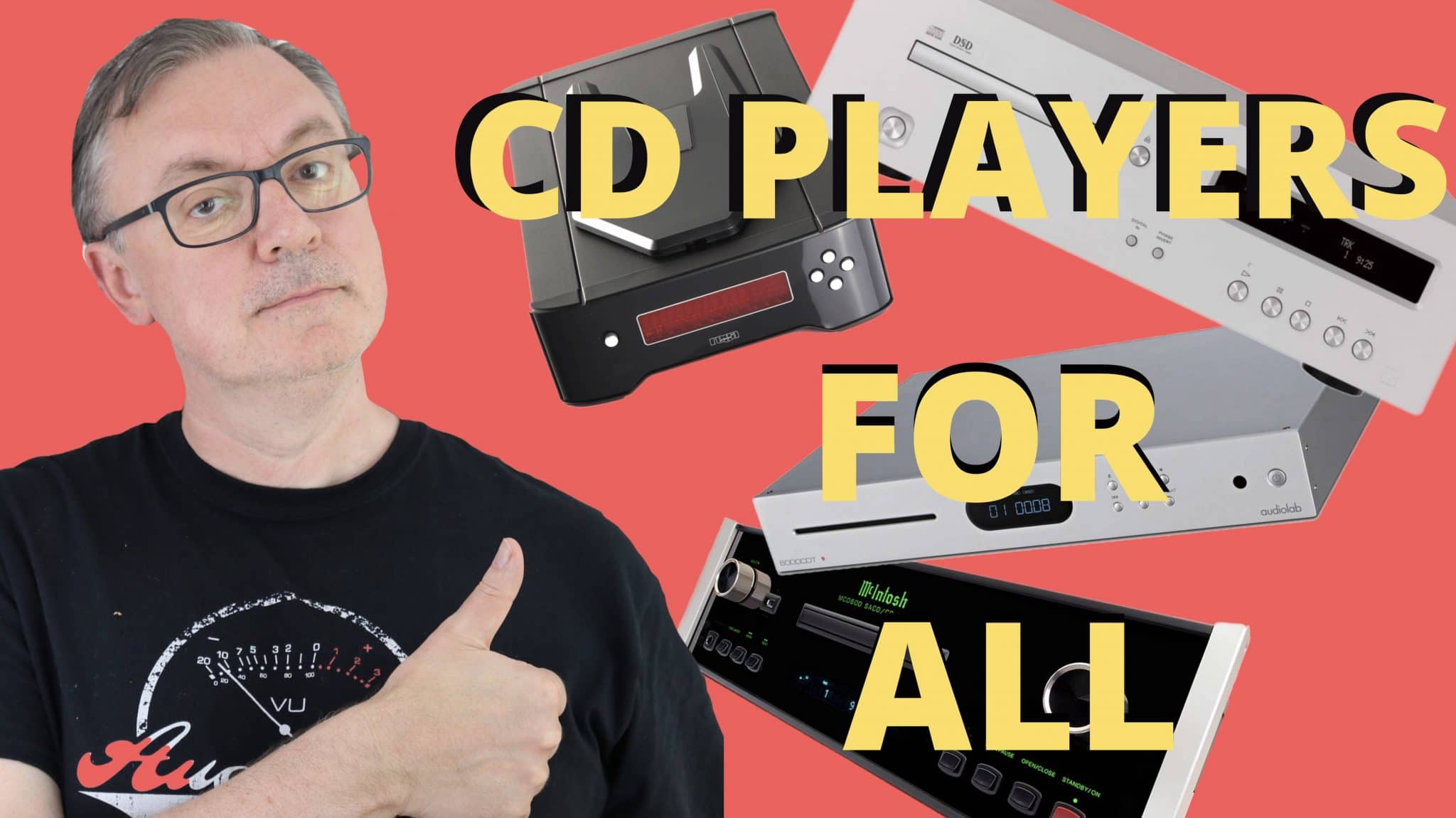The Article
BUYER’S GUIDE VIDEO: CD PLAYERS
12th December 2020

Paul Rigby firstly looks at broad issues regarding buying a CD Player. Then examines a range of players from differing price points
This is the first in a planned range of CD Buyer’s Guides. Mainly aimed at the beginner, hopefully everyone can take something away from this one.
[Don’t forget to check out my Patreon Page at www.patreon.com/audiophileman, for exclusive postings and more!]
To see the video, click:



I think Paul you should check out the Leak CDT transport ASAP. I did have the Audiolab CDT6000 but mysteriously it broke down after several months of use, I sent it back but due to the problems of repair during the lockdown etc I ended up with my ¬£379.00 refunded in full. I considered buying another but I saw that the Leak CDT had just been released and it had gotten a good review in Hifi World and it had the useful extra facility of playing files from USB. It also looked nice and ‘retro’ (my wife approved) so for the extra ¬£70 I thought “why not?” after all it is supposed to have the same cd mechanism as the Audiolab. My expectation when it arrived was that it would sound virtually identical to the (already impressive) Audiolab. I was wrong! Don’t misunderstand me but I’m not saying the Audiolab was missing much indeed I considered it to be the equal at least of my Cyrus CDTXT2 transport but compared to the Leak amazingly it is to my ears left standing. The Leak just sounds more ‘analogue’, smoother highs, more detailed mids and seemingly even better bass extension. Now I can’t do an A/B comparison for obvious reasons, also since the Audiolab unexpectedly died on me maybe it wasn’t working as well as it should’ve been (though I was very impressed) also it may have something to do with the interface with my Roksan K3 DAC but having said all that I find the Leak CDT to be more akin to listening to my modded Linn LP12 than a cd. I can actually forget that I’m listening to a cd. On my favourite 2 albums of the year (Tim Bowness/Peter Chilvers – Modern Ruins and Lunatic Soul – Through Shaded Woods) I’m hearing just more of everything but not in a typically cd way (ie detail ‘thrown at you’). I’ve asked my very un audiophile wife for her opinion and she loves the Nintendo Super NES look of it but she also has said she finds the music richer and fuller, so it’s not just ‘confirmation bias’ on my part it seems. Either way for ¬£70 more I’m astonished that Leak cd transport seems to be a step up on the already excellent Audiolab transport and I’d be interested to hear what you think?
Hmmm, I’ll give Leak a call. Let’s see what they say. Depends on review sample availability but we’ll see.
Hope you do manage to review the Leak CD Transport. I had problems with the Audiolab CD Transport being very vulnerable to electrics elsewhere in the house. Still looking
Hi Alan – yes, had a chat with Leak a couple of days ago, actually. I hope to receive a transport (and the amp with a bit of luck), later in January. So, they’re on the way 🙂
Cd review
Wound of been nice if you had mentioned what is a cd transport shmcd & sacd
Although i know it would have been for the people that my not no
Keep up the good work
Richard
Hopefully, I will be doing a video on SACD in the future. For now, I wanted to stick with the CD label – as stated on the tin.
NuPrime CDT-8 transport, connected to a RME ADI-2 Pro dac (further down the line: Rotel RB-850 power amp and Canton ct100 4way floorstanders, both from the nineties).
The NuPrime is a single speed drive, the disc spins in the same speed regardless wether the laser is reading near the center or at the outer rim. The digital bits are stored in memory and from there are transported to the dac with a new, precisely reclocked signal, the clocking is thus not depending on the readout speed. Error handling is also done in memory, before and not on-the-fly while passing the signal to a dac. It also offers upsampling options, thus allowing the dac for more headroom, if dsp or filtering computation is done further down the line.
At ~800,- € it is excellent value for the money, offering a very sturdy built quality. I just bought it recently and I am still in the process of rediscovering my old CDs with e big grin from ear to ear. The new transport and dac really do give me more detail while also bringing a fresh, still swinging-grooving listening experience.
Thanks Paul, good to hear of your positivity for the CD format (which I share). Its a shame that HDCD never became more widely adopted as it was a significant improvement over regular CD. My player is a Naim CD5XS with Flatcap2X power supply.
Hi Andy – agreed on HDCD. I think supporters were reduced to you, me and the Grateful Dead.
Thanks, Paul, for another great video! I can certainly understand how encoding the right bits on the CD is critical to the quality of the sound. What I don’t understand is why it is not possible to precisely recover the bits that have been encoded in the CD. If the data on the CD were a computer program, the bits would have to be precisely coded for the program to execute correctly. I assume a checksum or some such thing could validate the CD. Then when ripped to a drive, this process could be repeated again. At this point, the bits in the drive would be known to be identical to those on the master CD. I would think that playback would be precise at this point, controlled by a processor, eliminating all of the need for noise reduction on the CD drive itself. Am I missing something? Thanks!
Hi JP – and that’s the issue, I feel. There’s a perception about digital that confuses us a tad. Why isn’t it perfect?
Whether you’re talking CDs, downloads, streaming or whatever label you care to use. The word ‘digital’ is associated with CD. Digital means 1s and 0s. That sounds like binary. Binary is associated with science fiction, high tech stuff and computers. Computers are perfect. So CD sound should be perfect. Digital sounds black and white. With absolute boundaries. Everything neatly compartmentalised. If it works, it’s perfect.
Well, we heard all of that in the launch marketing back in 82. And then a lot of people stared to complain about CD’s metallic and harsh sound. That shouldn’t have happened. Not from perfect 1s and 0s, should it?
Digital – as is – would be fine if you only wanted to entertain an oscilloscope. The issue is that the principle receivers are our ears and they are influenced by far more variables than mere binary operations. For example, if any high-frequency noise or distortive effects decide to hitch a lift to the oncoming CD signal then our ears will ‘hear’ that too.
To answer your question, it *is* possible to recover the bits from a CD player although jitter [timing issues – our brains hate timing issues, our brains rebel against bad timing in music] can cripple that signal even before it leaves the chassis.
Even so, even if the source signal is bang on, the latter is affected in exactly the same way that analogue sound is affected from vinyl. CD is not immune to those issues. CD is merely a carrier. A bucket. That’s all CD is. That signal still has to go through the same pipe. That hasn’t changed. It’s the same pipe that a vinyl’s source signal travels though.
Whether you translate digital bits or whether you translate vibrations from a groove, from that point, the translation technologies are subject to a host of external and decidedly unfriendly forces that can affect the journey of that information from the source to your ears. If that journey is affected, even in the slightest, then sonic issues will occur.
As you can tell by the length of my reply, this is a big subject and I could (maybe should?) write a very large feature on it indeed. 🙂
Hi Paul, thanks much for your response. I hear what you are saying, and thought that I would describe the picture I have of the audio journey from source to satisfaction to see if I have it right. Please let me know where I may be off on this. My apologies in advance for the length.
At the source, we have the instruments, the voices, the music makers, all in a space with its own acoustics. The pressure waves are picked up by microphone transducers that convert them to analog electrical signals. There is great artistry here in many respects before the sound even becomes electronic. In the past, I assume that the audio was then encoded on analog tapes, mixing was done in analog, and an analog master was created to cut analog vinyl records (with a number of analog copies in between for capacity reason). I assume now that the the analog signals from the microphone outputs are are converted by an A to D converter, which has its own electromechanical properties, into digital tracks which are mixed digitally, again with great artistry. Once the mixes are completed, a digital master is created. Distribution should be much simpler as exact digital copies can be made. But, in any case, the digital information can be streamed or distributed on physical media (the CD). The digital information should be a perfect copy of the master at whatever the allowable sample rate and range are allowed by the media. Given the limitations technologies in the 1980’s we have the CD sampling rates that we do.
With Moore’s Law, computers have approximately doubled in capability every two years (we are now nearing the end of this, many say). As a result, computers today are over 500,000 times more powerful than they were in 1982 when CDs were first distributed. As a result, digital processing power is not an issue. Given this, I would assume that any computer driven device should be able to provide a perfect rendition of the distributed master copy. However, when that digital stream is converted by a D to A to an analog signal, things get magical again. And then when the analog signal is amplified, there is more room for magic. Then, there are the speakers that convert the electrical signals back to sound; big magic there. Then finally, the sound waves hit our ears, which are imperfect, which are converted to electrical pulses and interpreted by our brain as sound. The audiophile can hear things that others may not be able to notice, much as the wine connoisseur can interpret subtleties in taste. It would be interesting to see someone who was listening to an audio system that perfectly compensated for their hearing non-linearities would perceive that music as more pleasing than a neutral version.
So, given all this, there are many places for artistry, technical magic, and difference of opinion on what is pleasing to the ear. But, what I don’t understand is how the distribution of digital information makes a difference. I am sure that there is much that I don’t understand, so I await an education. Thanks!
There’s the thing, JP. I’m not an expert. I’m still learning. There’s plenty of gaps in my knowledge. I know a range of details in terms of digital technology but there’s plenty of information out there that I don’t know about. I know more about sound quality though and how that is affected by hifi technology.
One of the issues, if you flip the above over, is when digital technology experts restrict their opinions to the electronics and arrive at conclusions based only upon circuit boards and lasers. A perfectly working piece of digital – or analogue – technology might perform by the book but might sound poor when producing actual music.
You may remember those ‘perfect’ test results Japanese manufacturers included in their Ads during the 70s. The same technologies that sounded..ok. Sometimes good. But hardly great.
If I could offer one piece of advice, it would be to remember that there is more to sound realism that perfectly working electronics. There are hundreds of other variables which can scupper a well oiled piece of machinery: timing issues, vibration and high-frequency noise emanating from within the same chassis, dirty mains signals, room reflections, switch-mode power supply corruption, RFI and on and on. Which is why I spend so much time babbling on about reducing such ‘noise’.
Hi Paul, I have been doing some research on this and it appears that this is a huge area of contention. Of course, in theory there is no difference between theory and practice, and in the practice there is. 🙂
Have a safe and wonderful holiday!
Hi Paul,
Thanks once again for another interesting video – particularly in relation to PDO and differences in production (leaving aside the subject of the ‘loudness wars’ debate on the remastering process).
Like you I’m a big fan of CDs, but I also feel like I’m in a dwindling minority. In groups on social media, most of the people I’m chatting to appear to prefer vinyl in a big way – and really only purchase CDs when it comes to Super Deluxe Box Sets, which their array of extra tracks which are unavailable on vinyl.
I’ve become increasingly disillusioned with the quality of recent vinyl pressings – particularly in terms of noise between tracks and also pops & crackles on brand new pressings. When I’ve played original vinyl pressings from the ’80s & ’90s, I’ve found the quality of those pressings often much better. An example is Phoebe Bridgers’ album ‘Punisher’, which I initially purchased on coloured vinyl LP. Straight from the off, I found it popping and crackling. I enjoyed listening to the songs, but was frustrated by the underlying noise of the LP pressing. I then purchased the CD and popped it into the player and found myself listening to the gorgeous music rather than the imperfections present on the LP pressing.
I’ve owned a Marantz SA-10 for the past couple of years and found it nothing short of spectacular. There are too many positives to mention here – including its superb DAC, which is exposed, allowing connections from a laptop or iPod – and also its SA-CD support. Pretty much the only thing it doesn’t do is that it won’t play tracks in the pre-gap, such as ‘Through To Myself’ on David Gray’s ‘White Ladder’. It appears that Marantz stuck very closely to the red book standards when creating this player.
Thanks for you thoughts, Paul. Appreciate you taking the time to write. I’m partial to a slice of David Gray, myself.
I am enjoying my CD collection more than ever. I am able to add to it for a few pence by trawling charity shops. Remarkable buys are available if you persevere. I recently purchased a 4cd collection for ¬£1, the British Light Music Classics Series from Hyperion. Beautifully recorded, enjoyably annotated and wonderful fun. It was unfortunate that HDCD failed, but perhaps there was a reason…I had 3 HDCD players and all were unreliable and/or faulty. I gave up before the format faded away. The big jump in quality CD players began in the late 90’s I noticed. Separate transport/DAC is the way to go now. DAC quality is now a little better than it was 10 years ago, but most importantly, that very best performance is massively cheaper.
Thanks or you comments and glad to see that you’re picking up a few bargains there.